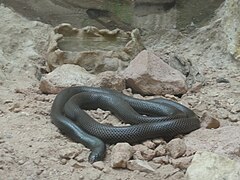Atractaspis
| Atractaspis[1] | |||
| A. Smith, 1849[2] | |||
 Przedstawiciel rodzaju – gleboryjec synajski (A. engaddensis) | |||
| Systematyka | |||
| Domena | eukarionty | ||
|---|---|---|---|
| Królestwo | zwierzęta | ||
| Typ | strunowce | ||
| Podtyp | kręgowce | ||
| Gromada | zauropsydy | ||
| Podgromada | diapsydy | ||
| Rząd | |||
| Podrząd | |||
| Infrarząd | Alethinophidia | ||
| Nadrodzina | Colubroidea | ||
| Rodzina | Lamprophiidae | ||
| Podrodzina | gleboryjcowate | ||
| Rodzaj | Atractaspis | ||
| Synonimy | |||
| | |||
| Gatunki | |||
| |||
| |||
| |||
Atractaspis – rodzaj jadowitych węży z podrodziny gleboryjcowatych (Atractaspidinae) w rodzinie Lamprophiidae.
Zasięg występowania
Rodzaj obejmuje gatunki występujące Afryce w Mali, Senegalu, Gwinei Bissau, Gwinei, Gambii, Sierra Leone, Liberii, Wybrzeżu Kości Słoniowej, Burkina Faso, Ghanie, Togo, Beninie, Nigrze, Niegerii, Kamerunie, Gwinei Równikowej, Republice Środkowoafrykańskiej, Gabonie, Kongu, Demokratycznej Republice Konga, Ugandzie, Rwandzie, Sudanie, Erytrei, Etiopii, Somalii, Kenii, Tanzanii (włącznie z Zanzibarem), Malawi, Zambii, Angoli, Namibii, Botswanie, Zimbabwe, Mozambiku, Eswatini i Południowej Afryce oraz w Azji Południowo-Zachodniej w Libanie, Izraelu, Jordanii, Arabii Saudyjskiej, Omanie i Jemenie[7].
Systematyka
Etymologia
- Atractaspis: gr. ατρακτος atraktos „wrzeciono, strzała”[8]; ασπις aspis, ασπιδος aspidos „żmija”[9].
- Brachycranion: gr. βραχυς brakhus „krótki”[10]; κρανιον kranion „czaszka”, od καρα kara, καρατος karatos „głowa”[11]. Gatunek typowy: Brachycranion corpulentum Hallowell, 1854.
- Eurystephus: gr. ευρυς eurus „szeroki”[12]; στεφος stephos „wieniec”[13]. Gatunek typowy: Elaps irregularis Reinhardt, 1843.
- Melanelaps: gr. μελας melas, μελανος melanos „czarny”[14]; ελοψ elops, ελοπος elopos „niemy”, tu w znaczeniu „jakiś rodzaj węża”[15]. Gatunek typowy: Melanelaps mcphersoni Wall, 1906 (= Atractaspis andersonii Boulenger, 1905).
- Hoseraspea: Shireen Hose, żona Raymonda Hosera, kontrowersyjnego australijskiego herpetologa; ang. asp „żmija”[6]. Gatunek typowy: Atractaspis microlepidota Günther, 1866.
Podział systematyczny
Do rodzaju należą następujące gatunki[7]:
- Atractaspis andersonii
- Atractaspis aterrima – gleboryjec leśny[16]
- Atractaspis battersbyi
- Atractaspis bibronii – gleboryjec pospolity[16]
- Atractaspis boulengeri
- Atractaspis branchi[17]
- Atractaspis congica
- Atractaspis corpulenta
- Atractaspis dahomeyensis
- Atractaspis duerdeni – gleboryjec dziobogłowy[18]
- Atractaspis engaddensis – gleboryjec synajski[18]
- Atractaspis engdahli
- Atractaspis fallax
- Atractaspis irregularis
- Atractaspis leucomelas
- Atractaspis magrettii
- Atractaspis microlepidota – gleboryjec natalski[18]
- Atractaspis micropholis
- Atractaspis phillipsi
- Atractaspis reticulata
- Atractaspis scorteccii
- Atractaspis watsoni
Przypisy
- ↑ Atractaspis, [w:] Integrated Taxonomic Information System (ang.).
- ↑ A. Smith: Illustrations of the zoology of South Africa, consisting chiefly of figures and descriptions of the objects of natural history collected during an expedition into the interior of South Africa, in the years 1834, 1835, and 1836; fitted out by "The Cape of Good Hope association for exploring Central Africa": together with a summary of African zoology, and an inquiry into the geographical ranges of species in that quarter of the globe. Cz. 3: Reptilia. London: Smith, Elder, & Co., 1838–1849, s. ryc. lxxi. (ang.).
- ↑ E. Hallowell. Remarks on the geographical distribution of reptiles, with descriptions of several species supposed to be new, and corrections of former papers. „Proceedings of the Academy of Natural Sciences of Philadelphia”. 7, s. 99, 1856. (ang.).
- ↑ E.D. Cope. Notes upon some reptiles of the Old World. „Proceedings of the Academy of Natural Sciences of Philadelphia”. 14, s. 337, 1863. (ang.).
- ↑ F. Wall. A new snake (Melanelaps mcphersoni) from the Andean Hinterland. „The Journal of the Bombay Natural History Society”. 17, s. 27, 1906. (ang.).
- ↑ a b R. Hoser. A reassessment of the Burrowing Asps, Atractaspis Smith, 1849 with the erection of a new genus and two Tribes (Serpentes: Atractaspidae). „Australasian Journal of herpetology”. 11, s. 57, 2012. (ang.).
- ↑ a b P. Uetz & J. Hallermann: Genus: Atractaspis. The Reptile Database. [dostęp 2019-06-25]. (ang.).
- ↑ Jaeger 1944 ↓, s. 26.
- ↑ Jaeger 1944 ↓, s. 24.
- ↑ Jaeger 1944 ↓, s. 34.
- ↑ Jaeger 1944 ↓, s. 61.
- ↑ Jaeger 1944 ↓, s. 87.
- ↑ Jaeger 1944 ↓, s. 221.
- ↑ Jaeger 1944 ↓, s. 133.
- ↑ Jaeger 1944 ↓, s. 80.
- ↑ a b W. Jaroniewski: Węże jadowite świata. Warszawa: Wydawnictwa Szkolne i Pedagogiczne, 1984, s. 70. ISBN 83-02-00977-6.
- ↑ M.-O. Rödel, Ch. Kucharzewski, K. Mahlow, L. Chirio, O. Pauwels, P. Carlino, G. Sambolah & J. Glos. A new stiletto snake (Lamprophiidae, Atractaspidinae, Atractaspis) from Liberia and Guinea, West Africa. „Zoosystematics and Evolution”. 95 (1), s. 107–123, 2019. DOI: 10.3897/zse.95.31488. (ang.).
- ↑ a b c Praca zbiorowa: Zwierzęta: encyklopedia ilustrowana. Warszawa: Wydawnictwo Naukowe PWN, 2005, s. 399. ISBN 83-01-14344-4.
Bibliografia
- Edmund C.E.C. Jaeger Edmund C.E.C., Source-book of biological names and terms, wyd. 1, Springfield: Charles C. Thomas, 1944, s. 1–256, OCLC 637083062 (ang.).
- J9U: 987007295875105171
- PWN: 3872185
- Britannica: animal/burrowing-asp










